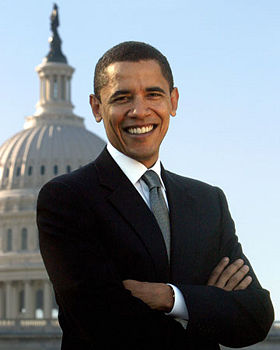Obama administration
Barack Obama entered office as President of the United States of America on January 20, 2009, as the nation's 44th president and the first African American to be U.S. head of state. His Vice President is Joe Biden, and his Secretary of State is Hillary Clinton, Obama's main rival for the Democratic Party nomination in the 2008 presidential election.[1]
Obama began his presidential term of office with a focus on foreign policy, particularly the Guantanamo detention camp and the Middle East. In line with his previous pledge to close the camp, Obama had military trials at Guantanamo suspended. He also called Middle Eastern leaders to pursue Arab-Israeli peace.[2] Obama appointed George Mitchell as a special envoy foe the Middle East, with former United Nations Ambassador Richard Holbrooke becoming special representative for Afghanistan and Pakistan.[3] On January 22, Obama signed an executive order authorizing the closure of the Guantanao camp within a year. This act, said Obama was to avoid "a false choice between our safety and our ideals," and to "restore the standards of due process and the core constitutional values that have made this country great even in the midst of war, even in dealing with terrorism." A second order banned torture by the U.S. Military, in effect terminating the Bush administration's authorization of extensive CIA interrogation techniques.[4]
Other issues
In 2009, Obama became one the few presidents to take the oath of office twice, Chief Justice John Roberts having made a mistake on inauguration day. The renewed oath has no implications for Obama's legitimacy as President, as the new term begins automatically following the previous president leaving office.[5]
References
- ↑ CNN: 'Hillary Clinton sworn in as secretary of state.' January 21, 2009.
- ↑ BBC: 'President Obama tackles first day.' January 21, 2009.
- ↑ CNN: 'George Mitchell named special envoy for the Middle East.' January 22, 2009.
- ↑ CNN: 'http://edition.cnn.com/2009/POLITICS/01/22/guantanamo.order/index.html.' January 22, 2009.
- ↑ CNN: 'Obama retakes oath of office after Roberts' mistake.' January 21, 2009.
